
- 580 pages
- English
- ePUB (mobile friendly)
- Available on iOS & Android
eBook - ePub
Dolls and Puppets
About this book
Many of the earliest books, particularly those dating back to the 1900s and before, are now extremely scarce and increasingly expensive. We are republishing many of these classic works in affordable, high quality, modern editions, using the original text and artwork.
Frequently asked questions
Yes, you can cancel anytime from the Subscription tab in your account settings on the Perlego website. Your subscription will stay active until the end of your current billing period. Learn how to cancel your subscription.
At the moment all of our mobile-responsive ePub books are available to download via the app. Most of our PDFs are also available to download and we're working on making the final remaining ones downloadable now. Learn more here.
Perlego offers two plans: Essential and Complete
- Essential is ideal for learners and professionals who enjoy exploring a wide range of subjects. Access the Essential Library with 800,000+ trusted titles and best-sellers across business, personal growth, and the humanities. Includes unlimited reading time and Standard Read Aloud voice.
- Complete: Perfect for advanced learners and researchers needing full, unrestricted access. Unlock 1.4M+ books across hundreds of subjects, including academic and specialized titles. The Complete Plan also includes advanced features like Premium Read Aloud and Research Assistant.
We are an online textbook subscription service, where you can get access to an entire online library for less than the price of a single book per month. With over 1 million books across 1000+ topics, we’ve got you covered! Learn more here.
Look out for the read-aloud symbol on your next book to see if you can listen to it. The read-aloud tool reads text aloud for you, highlighting the text as it is being read. You can pause it, speed it up and slow it down. Learn more here.
Yes! You can use the Perlego app on both iOS or Android devices to read anytime, anywhere — even offline. Perfect for commutes or when you’re on the go.
Please note we cannot support devices running on iOS 13 and Android 7 or earlier. Learn more about using the app.
Please note we cannot support devices running on iOS 13 and Android 7 or earlier. Learn more about using the app.
Yes, you can access Dolls and Puppets by Max Von Boehn in PDF and/or ePUB format, as well as other popular books in Media & Performing Arts & Performing Arts. We have over one million books available in our catalogue for you to explore.
Information
DOLLS AND PUPPETS
PART I: DOLLS
I
PREHISTORIC IDOLS
THE doll is the three-dimensional representation of a human figure, a plastic creation, which, however, is far removed from the sphere of the fine arts. It has about as much in common with art as the ape has with homo sapiens. Both enjoy a complete freedom from dependence on material: in all three realms of nature there is no substance out of which a doll or a work of art cannot be made. In their dimensions also they are so far alike that each may fluctuate in size from a few millimetres to a considerable number of metres. Apart from that it is easier to feel the difference between them than to frame an indisputable definition. This is due to the fact that they proceed from the same source. In the doll we have before us the beginnings of fine art; and to-day, following the precedent of Alois Riegl, these beginnings are recognized to lie in the field of sculpture. Sculpture has the power of reproducing directly corporeal forms. Its subject not only can be appreciated through the eye, like drawing and painting, but, since it can be touched and handled on all sides, appeals to all the senses. Plastic art can be grasped even by primitive man without special training, for it remains within the sphere of all living things familiar with the three dimensions of matter. Painting and drawing presuppose a cultural development which, whether in the creative process or in the appreciation, must abstract from the reality and mentally translate the object on to a flat plane.
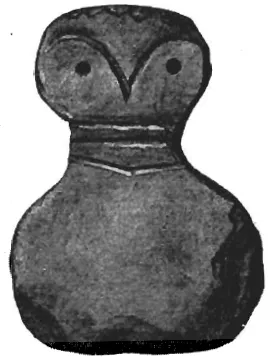
FIG. 1. MARBLE IDOL FROM TROY (THIRD BURNED CITY)
The first, still tentative, attempt at formative plastic modelling is the doll, but when this plastic modelling develops into art the doll does not disappear; one might say that while the doll was not permitted to enter into art’s holy of holies it was allowed to remain in the courtyard of the temple. Art, in rejecting the nonessential and the fortuitous, has striven to present a reflection of the soul; the doll has renounced this psychological motive in order to accentuate and intensify the shallow and the external. The creations of art have to take the spectator’s imagination into account; the doll does not allow the slightest scope for the play of the imagination. The sculptor of the present day works according to the same rules and with the same methods as his predecessor thousands of years ago. He directs his attention to the emotions and reaches the same result as they. The doll, on the contrary, has forced into its service all the refinements of a progressive technique, not striving toward an æsthetic impression, but aiming at ever completer illusion. It can come surprisingly close to nature, but the nearer it approaches its goal the farther is it removed from art; it can create an illusion, but the true essence of artistic enjoyment—the raising of the soul to a higher plane—is denied to it.
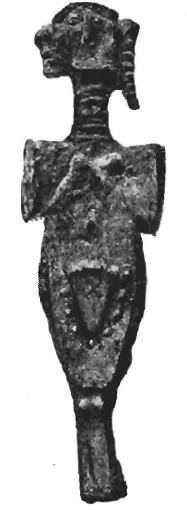
FIG. 2. LEAD IDOL FROM TROY
Properly speaking, the doll is regarded now only as a child’s toy, but, if its historical development be examined, it will be found that the toy doll appears at a comparatively late stage. The doll form, the more or less complete representation of man, existed for thousands of years before the first child took possession of it. For adults it possessed an occult significance with mystical-magical associations which in an inexplicable way united the present and the past and reached deep into the world of the unseen.
If the genesis of the doll is sought for it will be found, according to the views of Ernst Vatter and of other scholars, in a quality, which is shared alike by primitive races and by children—namely, the ability to discern human and animal forms in all sorts of freaks of nature. Natural and fortuitously developed forms, recognizable in rocks, horns, bones, branches, and roots, must have stimulated the imagination of primitive men, and roots, and must have been the point of departure for the shaping, often with but trifling modifications, of figures which were at least something like human beings. In this connexion mention must be made of the so-called Lösskindel (loess dolls)—concretions of loam which are occasionally found at Löss and by chance often assume human form. The museum at Strasbourg possesses several examples from Achenheim. Among Palæolithic sculptures it is often to be recognized that the original shape of the material has evidently suggested the object finally represented by the artist. These ‘figure stones,’ natural fragments of rock in which the more or less striking resemblance to human or animal forms seems to have been still further accentuated by the work of the artist, stand at the very beginning of plastic statuary, and H. Klaatsch would associate them with the otherwise entirely inartistic Neanderthal man. In these he sees the first attempts made to depict natural objects. This tendency to let natural forms which resemble certain objects influence the modelling of figures has remained until the present day peculiar to the spirit of the folk, and forms a striking characteristic in the wood-carving technique of the Alpine pastoral art.

FIG. 3. FLAT BONE IDOLS FROM TROY
For long the sculpture which was concerned with the representation of human beings remained stationary at this stage of strict dependence on the forms offered directly by nature itself. Hörnes draws attention to the fact that periods of incalculable length, whole thousands of years of primitive culture, are filled with precisely the same sort of art products, and that this runs completely counter to our expectation of finding progress and development everywhere or to our theories cast in terms of decadence and decay.

FIG. 4. AMBER IDOL FROM SCHWARZORT
To the sophisticated modern eye the small plastic figures of prehistoric times will hardly seem like images of men at all. They are block-like, body, head, and limbs of one piece, with the distribution of the limbs indicated by mere scratches. Originally perhaps the features were accentuated by colours which have been obliterated by their long lying in the ground. The art of representation among the prehistoric peoples in this respect runs parallel with that of the nature peoples. There too are figures lacking completely arms and legs; a step forward is marked when two independent legs can be traced; the insertion of arms usually came last. The correspondence between the art of the polar races and that of the Palæolithic is so great that Hildebrand assumes a direct descent of the Arctic peoples from the Palæolithic, regarding the Eskimos as the Aurignac race of to-day. He makes this assertion on the basis of the small statuettes which are by them produced skilfully with the same materials and with the same tools as were at the command of the Palæolithic peoples.
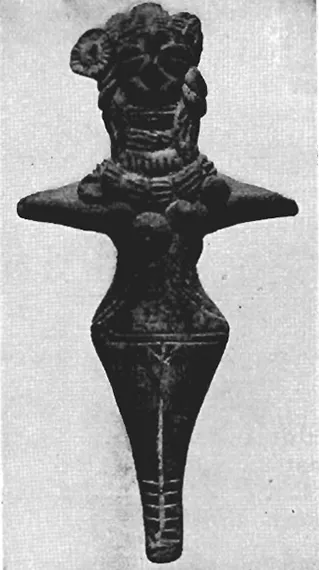
FIG. 5. RED CLAY IDOL
About 3000 B.C.
The discoveries made by Schliemann in the most ancient strata of Troy permit us to follow the development from the formless stone to the human figure. First come the small coniform stones, which only gradually assume human shapes, and do so only if the observer brings with him a lively imagination and a keen desire to recognize this metamorphosis. In the most ancient specimens the head is wanting; a pointed piece of stone to indicate a head marks a higher stage; then a long developed neck appears; and finally small indentations are to be noted as characteristic features, a great advance being made when scratched lines indicate hair, eyes, nose, frontal arches, and necklace. So far as arms are concerned, this type of art does not go beyond the barest suggestion. These sculptures of the Neolithic Age, also called ‘board idols,’ because of their excessively flat-shaped bodies, give the impression of having originated from plain flat pebbles which could be adapted to human shape by a simple process of cutting and boring.
Closely allied in form to these are the little amber figures, likewise belonging to the Stone Age, which have been dredged up in the Kurisches Haff, East Prussia. For long men adhered to this board-like type. When, however, the artists proved themselves no longer dependent on stones they had found, but had learned to model in clay, there appeared at Cyprus idols of baked clay which just indicated the features, hair, and ornaments by means of white, indented, decorative lines. Only in the upper part of the body can modelling in a true sense be spoken of; the lower part becomes a rectangular ‘cake,’ which, according to the highly plausible suggestion of Hörnes, was probably covered with pieces of cloth. Among the bronzes of the Hallstatt and of the first Iron Age these flat idols are again met with; worked in metal, they give the impression of sawed-out or stamped-out tin. A whole depot of such little dolls, which might be regarded as the ancestors of our tin soldiers, was brought to light at Todi, near Perugia.
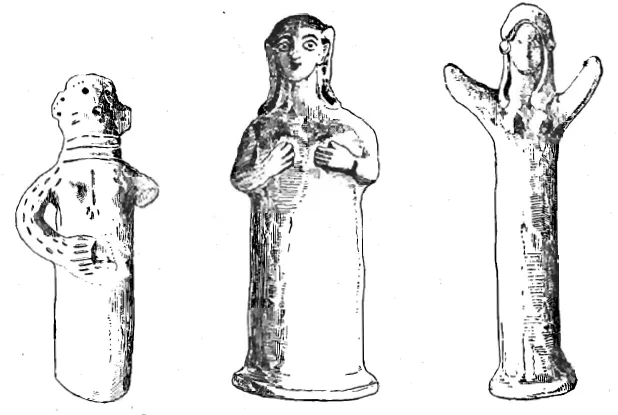
FIG. 6. CAKE-FORMED IMAGES IN TERRA-COTTA
Cyprus
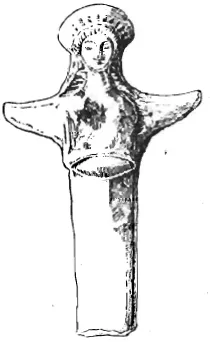
FIG. 7. PHOENICIAN TERRA-COTTA IDOL
Sidon

FIG. 8. FEMALE TERRA-COTTA IDOL FROM NIPPUR, CHALDÆA
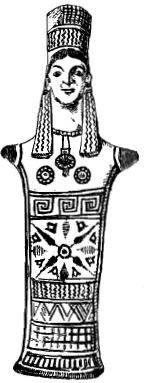
FIG. 9 EARLY TERRA-COTTA IDOL FROM TANAGRA
The ‘board idols’ of Hissarlik are undoubtedly the most primitive examples of prehistoric sculpture, but they are by no means the most ancient. Indeed, the attempts to produce representations of the human form might be traced back to the beginnings of the...
Table of contents
- Cover
- Title
- Note on Puppets
- Acknowledgment
- Contents
- Illustrations
- Illustrations in The Text
- Part I: Dolls
- Part II: Puppets
- The Puppet-Play of Doctor Faust
- Index